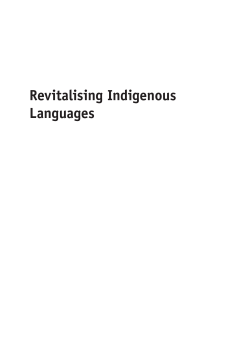
BOOK
Revitalising Indigenous Languages
Dr. Marja-Liisa Olthuis | Suvi Kivelä | Dr. Tove Skutnabb-Kangas
(2013)
Additional Information
Book Details
Abstract
The book tells the story of the Indigenous Aanaar Saami language (around 350 speakers) and cultural revitalisation in Finland. It offers a new language revitalisation method that can be used with Indigenous and minority languages, especially in cases where the native language has been lost among people of a working age. The book gives practical examples as well as a theoretical frame of reference for how to plan, organise and implement an intensive language programme for adults who already have professional training. It is the first time that a process of revitalisation of a very small language has been systematically described from the beginning; it is a small-scale success story. The book finishes with self-reflection and cautious recommendations for Indigenous peoples and minorities who want to revive or revitalise their languages.
This book is a wonder! - the uplifting story of a program that has made a very major difference in the revitalization of Aanaar Saami, through the empowerment of the Missing Generations of speakers - the adults who could, once they learn the language, teach or raise children in the endangered language. This account demonstrates how the vision and energy of a few can have a powerful effect on language and cultural survival. Three cheers for Marja-Liisa Olthuis and the brave women who worked with her! What a difference they have made. This is a must-read for all communities and their friends who are trying to revitalize their endangered languages. Leanne Hinton, Professor Emerita, University of California at Berkeley, USA
Chock-full of on-the-ground experience, Olthuis, Kivelä and Skutnabb-Kangas present a research-based model for language revitalization among a critical age group: professional adults. Meticulously detailed, the book takes readers inside the Aanaar Saami language education program, introducing its strategies, management and the dedicated learners and master teachers at its heart. The authors' message is clear: yes, it is possible to recover a 'small' minoritized language! Recognizing that every community must chart its own way, the authors offer a practical, hopeful account with invaluable language revitalization lessons.
Teresa L. McCarty, G.F. Kneller Chair in Education and Anthropology, University of California-Los Angeles, USA
"Revitalising indigenous languages: How to recreate a lost generation" is a remarkable and inspirational book that chronicles the language revitalization efforts, triumphs, and tribulations of the Complementary Aanaar Saami Language Education (CASLE) program in Finland...It is an engaging book driven by the three authors’ personal experiences, dedication, andcommitment to Aanaar Saami. The book is well suited for language revitalization researchers, graduate students interested in the topic, and ITM community members alike.
Mahalo nui loa to the authors of this important book! Ancestral languages are crucial components of healthy indigenous communities. Yet once a language is lost among childbearing adults, it seems impossible to gain it back again. Developing a resource of fluent second language speaking adults is the answer. This work tells how to reach that crucial step - and with very small languages. E ola nā ʻōlelo ʻōiwi a kākou!
Marja-Liisa Olthuis is University Lecturer at University of Oulu, Finland. Her major interests are the Saami languages, Finnish, language revitalisation, lexicology, second/foreign language teaching and translating.
Suvi Kivelä is a researcher at the Saami Archives in Finland. She has worked as a news broadcaster at YLE, Finland's national public service broadcasting company. She is one of the Complementary Aanaar Saami Language Education graduates.
Tove Skutnabb-Kangas (Emerita) has been actively involved with struggles for language rights for five decades. Her research interests include linguistic human rights, linguistic genocide, linguicism (linguistically argued racism), mother-tongue-based multilingual education and the relationship between linguistic and cultural diversity and biodiversity.
The authors describe the many obstacles faced by anyone interested in indigenous language revitalization, especially the lack of teaching materials, that need to be overcome and offer valuable insights on how this can be done.
Jon Reyhner, Northern Arizona University, USA to be published in the Magazine of the National Association for Bilingual Education
Table of Contents
| Section Title | Page | Action | Price |
|---|---|---|---|
| Contents | vii | ||
| Acknowledgements | xi | ||
| 1 Introduction | 1 | ||
| 2 How Did the CASLE Project Start? | 7 | ||
| 3 Aanaar Saami: A Small Saami Language | 23 | ||
| 4 The CASLE Revitalisation Method | 35 | ||
| 5 The CASLE Year | 55 | ||
| 6 Complementary Aanaar Saami Language Education as a Project: CASLE 2009–2010 | 105 | ||
| 7 What Has CASLE Achieved? What Does the Future Hold? | 129 | ||
| Info Boxes | 167 | ||
| References | 230 |
